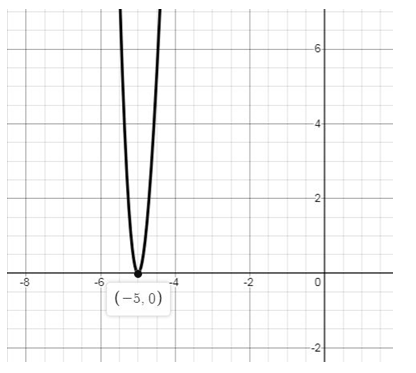
Concept explainers
a.
To find: all zeros of the function.
a.
Answer to Problem 100CR
Explanation of Solution
Given information:
Concept used:-
Rational root test:- Let f(x) be a polynomial and c be constant term in f(x) and a is leading coefficient of f(x) then ratio of possible divisors of constant term and leading coefficient can rational zeros of function.
Rational root =
Calculation:- Possible divisors of constant term are
1stmethod:-
Since, we know zeros of a polynomial satisfies polynomial so, by putting these numbers in polynomial we can check which number is zero of polynomial.
2ndmethod: - using synthetic division method we can also check the roots of polynomial.
Now, we check, is (x+5) factor of

Hence, (x+ 5) is factor of
So,
Applying shreedhracharya for
So,
Therefore, (1) becomes
So, zeros of function are
b.
To represent: the polynomial as product of linear factor form.
b.
Answer to Problem 100CR
Explanation of Solution
Given information:
Zeros of given function are
Calculation:
From part (A) and equation (2), we have
c.
the x- intercept of function and verify it using graphing ultity.
c.
Answer to Problem 100CR
Explanation of Solution
Given information:
From part (B) we have
Concept used:-
The graph of polynomial cuts the x- axis at its real zeros.
Calculation:-
Since, we have
Real zeros of polynomial is -5.
So graph of given function will cut x-axis at x= -5
Verification:-

Using graph we can see graph of function cuts x-axis at x = -5.
Chapter 2 Solutions
EP PRECALC.GRAPHING APPR.-WEBASSIGN-1YR
- Find the accumulated amount A, if the principal P is invested at an interest rate of r per year for t years. (Round your answer to the nearest cent.) P = $3800, r = 4%, t = 10, compounded semiannually A = $ 5645.60 × Need Help? Read It SUBMIT ANSWER [3.33/6.66 Points] DETAILS MY NOTES REVIOUS ANSWERS ASK YOUR TEACHER TANAPCALC10 5.3.001.EP. PRACTICE ANOTHER Consider the following where the principal P is invested at an interest rate of r per year for t years. P = $3,100, r = 4%, t = 10, compounded semiannually Determine m, the number of conversion periods per year. 2 Find the accumulated amount A (in dollars). (Round your answer to the nearest cent.) A = $ 4604.44arrow_forwardForce with 800 N and 400 N are acting on a machine part at 30° and 60°, respectively with a positive x axis, Draw the diagram representing this situationarrow_forwardI forgot to mention to you to solve question 1 and 2. Can you solve it using all data that given in the pict i given and can you teach me about that.arrow_forward
 Calculus: Early TranscendentalsCalculusISBN:9781285741550Author:James StewartPublisher:Cengage Learning
Calculus: Early TranscendentalsCalculusISBN:9781285741550Author:James StewartPublisher:Cengage Learning Thomas' Calculus (14th Edition)CalculusISBN:9780134438986Author:Joel R. Hass, Christopher E. Heil, Maurice D. WeirPublisher:PEARSON
Thomas' Calculus (14th Edition)CalculusISBN:9780134438986Author:Joel R. Hass, Christopher E. Heil, Maurice D. WeirPublisher:PEARSON Calculus: Early Transcendentals (3rd Edition)CalculusISBN:9780134763644Author:William L. Briggs, Lyle Cochran, Bernard Gillett, Eric SchulzPublisher:PEARSON
Calculus: Early Transcendentals (3rd Edition)CalculusISBN:9780134763644Author:William L. Briggs, Lyle Cochran, Bernard Gillett, Eric SchulzPublisher:PEARSON Calculus: Early TranscendentalsCalculusISBN:9781319050740Author:Jon Rogawski, Colin Adams, Robert FranzosaPublisher:W. H. Freeman
Calculus: Early TranscendentalsCalculusISBN:9781319050740Author:Jon Rogawski, Colin Adams, Robert FranzosaPublisher:W. H. Freeman
 Calculus: Early Transcendental FunctionsCalculusISBN:9781337552516Author:Ron Larson, Bruce H. EdwardsPublisher:Cengage Learning
Calculus: Early Transcendental FunctionsCalculusISBN:9781337552516Author:Ron Larson, Bruce H. EdwardsPublisher:Cengage Learning





